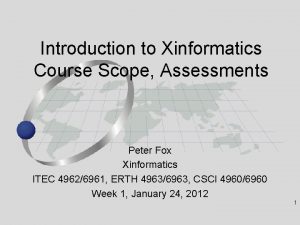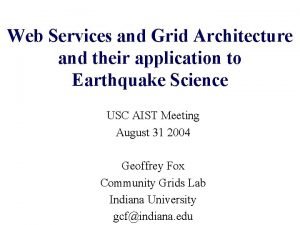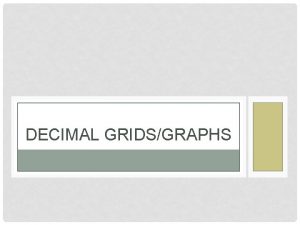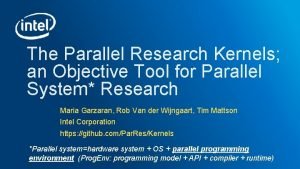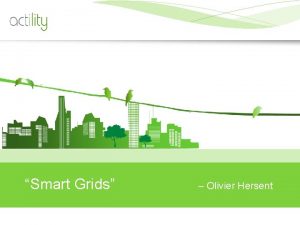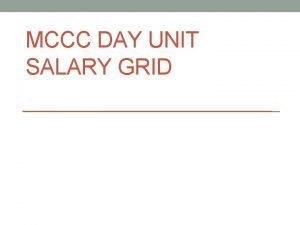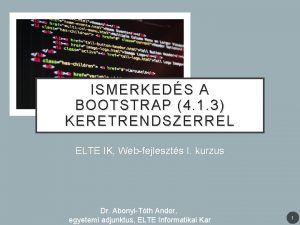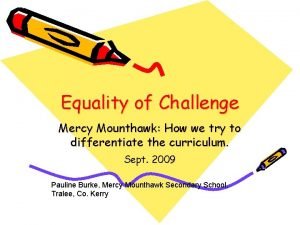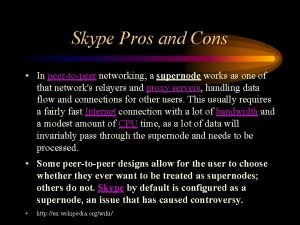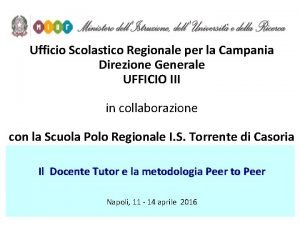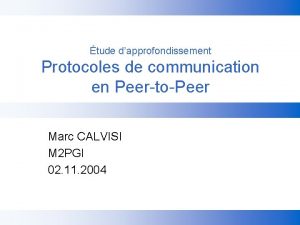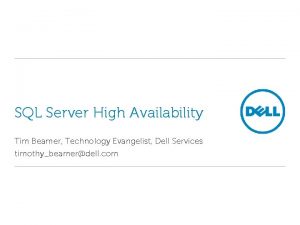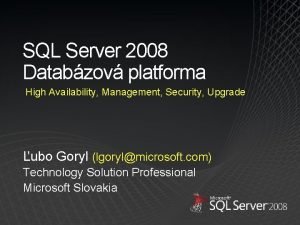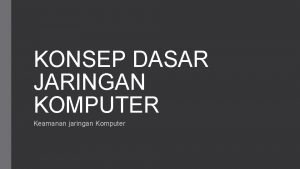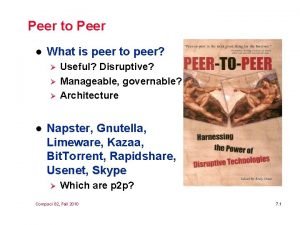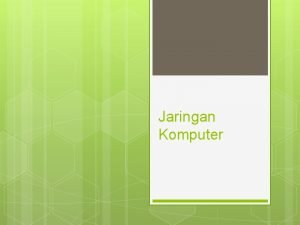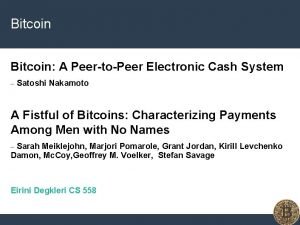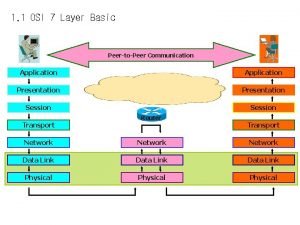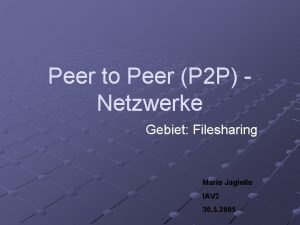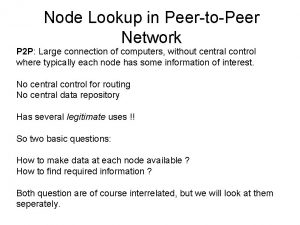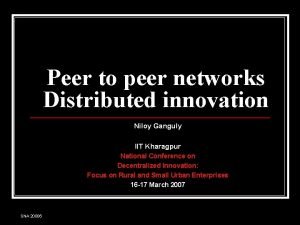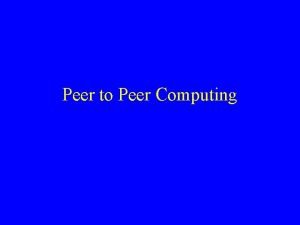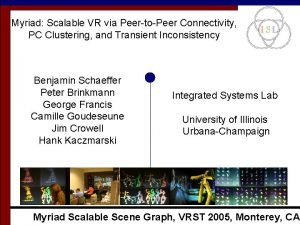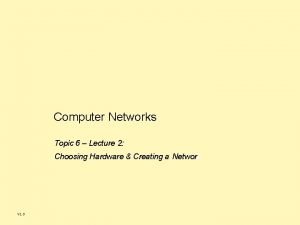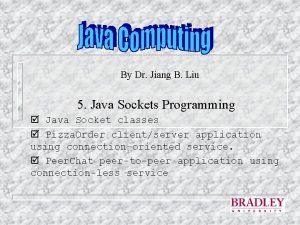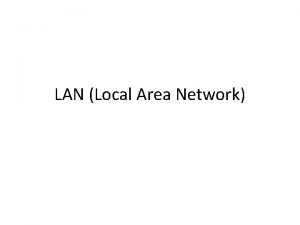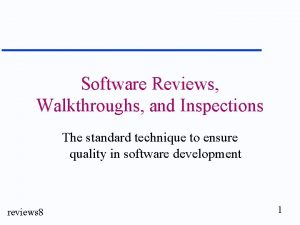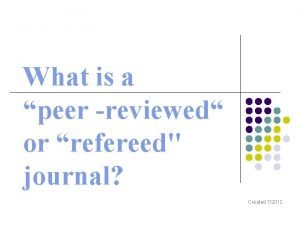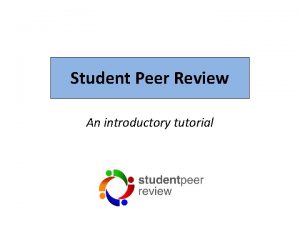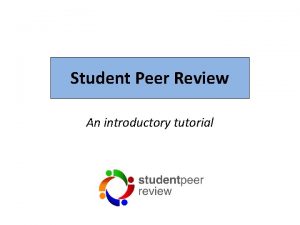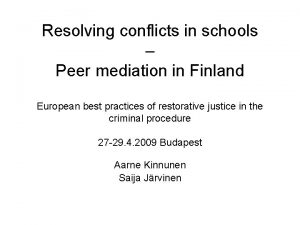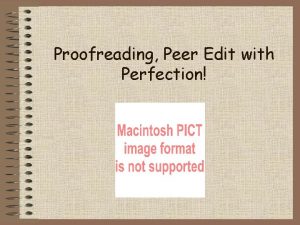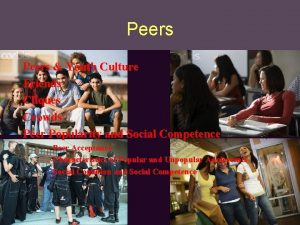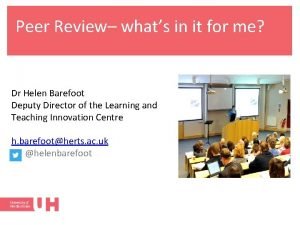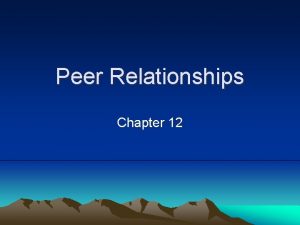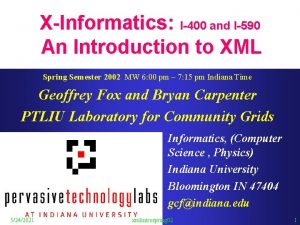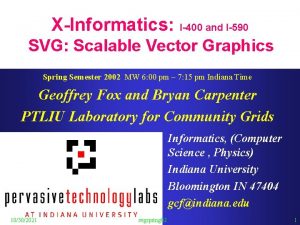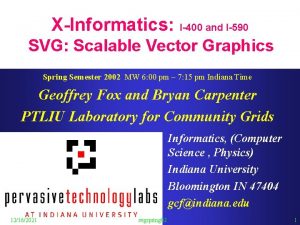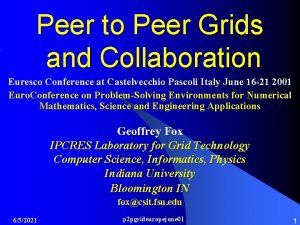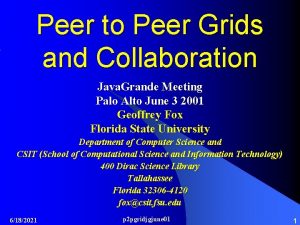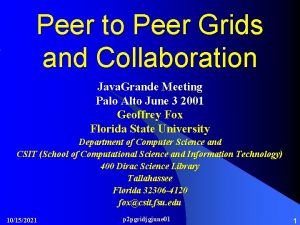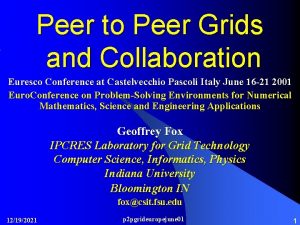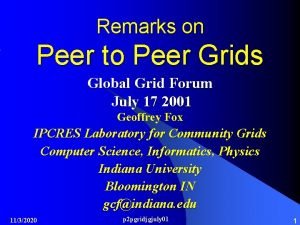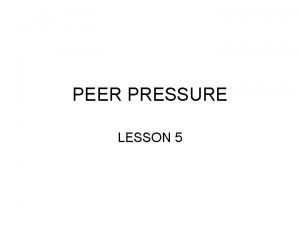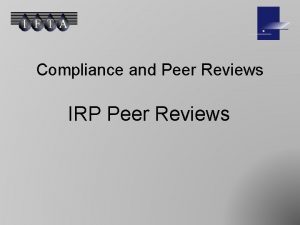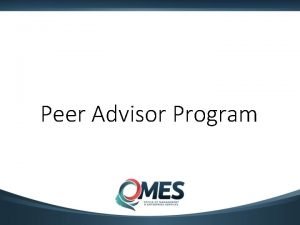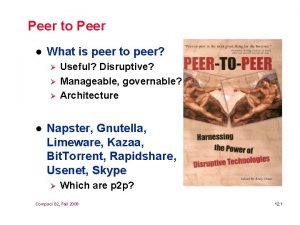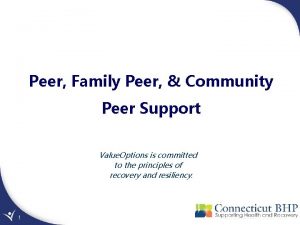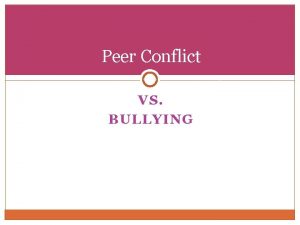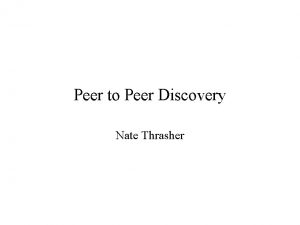XInformatics I400 and I590 Grids Peer to Peer




















































- Slides: 52

X-Informatics I-400 and I-590 Grids, Peer to Peer Networks Spring Semester 2002 MW 6: 00 pm – 7: 15 pm Indiana Time Geoffrey Fox and Bryan Carpenter PTLIU Laboratory for Community Grids Informatics, (Computer Science , Physics) Indiana University Bloomington IN 47404 gcf@indiana. edu 2/26/2021 uri="gxos: //ptliu/communitygrid/courses/xinformatics" title="Grids P 2 P" 1

Computational Grids • Exploit the analogy with electricity – make using a computer as natural as plugging an appliance (PDA, PC) into a wall socket • Make the ensemble of computers, storage devices, scientific instruments on the web “seamlessly accessible” • Link components of the grid together to solve a single problem – Clusters, metacomputers • There are computational grids, education grids, information grids (web), shopping grids etc. – The Grid is Web on steroids • Generic access implies standards for API’s and protocols and services • Everything we have learnt applies to Grids • USC (ISI Carl Kesselmann) and Argonne (Ian Foster) pioneered grids • IBM using as a major (marketing) thrust for “high-end systems” 2/26/2021 uri="gxos: //ptliu/communitygrid/courses/xinformatics" title="Grids P 2 P" 2

Volta Presents Battery to Napoleon Paris 1801 2/26/2021 uri="gxos: //ptliu/communitygrid/courses/xinformatics" title="Grids P 2 P" 3

Global Grid Forum 2/26/2021 uri="gxos: //ptliu/communitygrid/courses/xinformatics" title="Grids P 2 P" 4

Issues for Grids • Are the grid components pretty much fixed – such as giant ASCI supercomputers • Are they fleeting and mobile such as internet connected cell phones – The set of IP enabled home sensors, appliances and controllers is a grid • What are requirements? – Security, anonymity, performance, ease of use … • Different components and requirements implies that not likely to be just one grid but a federation of interoperable grids • What are the “standards” and who sets them • How do universities build grids they care about on graduate time while industry builds and abandons remarkable technologies on Internet time 2/26/2021 uri="gxos: //ptliu/communitygrid/courses/xinformatics" title="Grids P 2 P" 5

Foster’s Grid architecture • What is difference between protocol (SOAP, HTTP) and Application interface (HTML, MIME) 2/26/2021 uri="gxos: //ptliu/communitygrid/courses/xinformatics" title="Grids P 2 P" 6

Computational Power Grid 2/26/2021 uri="gxos: //ptliu/communitygrid/courses/xinformatics" title="Grids P 2 P" 7

Electrical v. Computational Grid 2/26/2021 uri="gxos: //ptliu/communitygrid/courses/xinformatics" title="Grids P 2 P" 8

Electrical v. Computational Grid 2/26/2021 uri="gxos: //ptliu/communitygrid/courses/xinformatics" title="Grids P 2 P" 9

Electrical v. Computational Grid 2/26/2021 uri="gxos: //ptliu/communitygrid/courses/xinformatics" title="Grids P 2 P" 10

Electrical v. Computational Grid 2/26/2021 uri="gxos: //ptliu/communitygrid/courses/xinformatics" title="Grids P 2 P" 11

ASCI Grid • Link the multi teraflop computers of ASCI together – today 12, 3 and 2 teraflops. By 2005 100, 60 and 20 teraflops 2/26/2021 uri="gxos: //ptliu/communitygrid/courses/xinformatics" title="Grids P 2 P" 12

IPG Architecture 2/26/2021 uri="gxos: //ptliu/communitygrid/courses/xinformatics" title="Grids P 2 P" 13

Information Power Grid Led by NASA Ames 2/26/2021 uri="gxos: //ptliu/communitygrid/courses/xinformatics" title="Grids P 2 P" 14

Experimental Particle Physics Grid 2/26/2021 uri="gxos: //ptliu/communitygrid/courses/xinformatics" title="Grids P 2 P" 15

Earthquake Engineering Grid • Links Experimental Facilities, Compute resources, people 2/26/2021 uri="gxos: //ptliu/communitygrid/courses/xinformatics" title="Grids P 2 P" 16

Application Issues I • Classic Multidisciplinary Meta-Applications: – Coupled Ocean Atmosphere – Coupled Fluids Structures Electromagnetic etc. – NASA IPG Focus – Do. D SBA (Simulation Based Acquisition) • Power Users – Distribute “classic tightly coupled” HPCC codes across machines – Difficult across the country but practical in a machine room • Distributed Simulations – FMS -- should be DMSO compliant -- use HLA RTI SPEEDES etc. – Large Scale Applications CMS NSS JSIMS etc. – SIMAF ASC Cockpit Simulation Facility (Thunder/Storm Applications) 2/26/2021 uri="gxos: //ptliu/communitygrid/courses/xinformatics" title="Grids P 2 P" 17

Peer to Peer Computing Napster Gnutella seti@home ……… 2/26/2021 uri="gxos: //ptliu/communitygrid/courses/xinformatics" title="Grids P 2 P" 18

P 2 P: Peer-to-Peer Networks • Peer-to-Peer Networks are considered to be the next "killer application" for the Internet. • There are several important technology challenges and applications that vary from the sublime to the ridiculous. • Our goal is not to espouse any particular approach but rather to bring this area to the students' attention and suggest some emerging research areas and opportunities. • Like most such over hyped concepts, P 2 P is rather loosely defined and covers a set of rather disparate ideas. • Perhaps the only common theme is a client oriented view of the world and P 2 P can be thought of as Power to the People. – Clients do most of the work, communicate with each other and really are the most important computers; – Servers may be around and even essential but remain subservient to the clients. • We will first discuss the most well-known and popular P 2 P system, Napster and then try to be a little more systematic in covering the other players in this field. 2/26/2021 uri="gxos: //ptliu/communitygrid/courses/xinformatics" title="Grids P 2 P" 19

P 2 P References • General discussions on P 2 P technology can be found at two good web sites; – http: //www. openp 2 p. com from the O'Reilly group and – http: //www. peer-to-peerwg. org/ as an industry working group originally initiated by Intel. • There is a remarkable book Peer-to-Peer: Harnessing the Power of Disruptive Technologies by Andrew Oram, Nelson Minar, Clay Shirky, Tim O'Reilly (March 15, 2001, O'Reilly & Associates; ISBN: 059600110 X) ; – This has several articles describing either key systems or key services • Disruptive Technology(DT): One that does something (perhaps a new capability) far better than previous best practice; it does old things less well at the start but gradually catches up. – The Web itself is a DT: hyperlinks empower new ways of doing things. Browsers are (initially) clumsier user interface than traditional GUI’s. 2/26/2021 uri="gxos: //ptliu/communitygrid/courses/xinformatics" title="Grids P 2 P" 20

Napster I • Shawn Fanning developed the original Napster application and service in January 1999 while a freshman at Northeastern University. • Napster allowed any client to advertise any MP 3 files stored on its disk and choose to download MP 3 files from other clients connected to the Napster server network. • It is said that Shawn was taking a computer-programming course at Northeastern, but had to buy a programming book to build Napster ……. . • Like most good ideas, Napster was designed to solve a real need - in this case to allow Shawn, a musician himself, to share his music with his friends on campus. 2/26/2021 uri="gxos: //ptliu/communitygrid/courses/xinformatics" title="Grids P 2 P" 21

Napster II • The system has become staggeringly popular. Quoting a legal opinion from last summer, approximately 10, 000 music files are shared per second using Napster, and every second more than 100 users attempt to connect to the system and there will be 75 million Napster users by the end of 2000. http: //news. cnet. com/News/Pages/Special/Napster/napster_p atel. html – Current legal debate has increased instantaneous use • Napster has some other typical P 2 P services; Instant Messenger, chat rooms, "Buddy lists" and information about "hot music" (music portal) but the key feature is the ability to share files between any Internet connected consenting clients. • This is roughly the Web version of NFS (Network File System) familiar from traditional computing environments. 2/26/2021 uri="gxos: //ptliu/communitygrid/courses/xinformatics" title="Grids P 2 P" 22

Napster III: Key Features • MP 3 files are important as a popular digital encoding for audio files; • it is straightforward to "rip" files off an audio CD and look up key meta-data (Artist, Title etc. ) in a CDDB database on the Web (http: //www. gracenote. com/). – Length of songs uniquely identifies CD’s • The audio and meta-data can be stored and accessed as a single unit. • Although a server is used to establish the initial connection, the file transfer is done efficiently - directly from client to client; a P 2 P service. • This is an improvement over most NFS systems where use of distributed files is not easy (except possibly for the originator who named file) as usually all you have is a cryptic filename. • The added value of meta-data for files lies at the heart of the Semantic Web - a vision from the W 3 C Web Consortium related to P 2 P. http: //www. w 3. org/2001/sw/ 2/26/2021 uri="gxos: //ptliu/communitygrid/courses/xinformatics" title="Grids P 2 P" 23

Napster IV • Now Napster happens to be controversial as the audio files are typically copyrighted but the two concepts – – Web-based NFS and meta-data enhanced files are fundamental and broadly applicable. • The legal debate continues; at the Napster site, http: //www. napster. com we are exhorted – "Napster is under fire! The recording industry won't stop until they've shut down file sharing. We're not going to let them. You can make a difference. Join the Napster Action Network now! You have the power to keep file-sharing over the Internet alive. Highpowered lobbyists and big campaign contributions should never win out over the will of the people. " – However the legal problems are a feature of the particular content; the technology is lasting and in my opinion uncontroversial and one implementation of an essential P 2 P capability. 2/26/2021 uri="gxos: //ptliu/communitygrid/courses/xinformatics" title="Grids P 2 P" 24

Napster Like Services I • There some 200 available Napster clones to support this area http: //www. ultimateresourcesite. com/napster/main. htm • Currently the most popular is Imesh [http: //www. imesh. com], which has some 2 million users and can share any type of file. • Some of the best known file sharing systems are – Mojo. Nation [http: //www. mojonation. net], – Freenet [http: //freenet. sourceforge. net/] , – Gnutella [http: //gnutella. wego. com/] • These three are not server based like Napster but rather support waves of software agents expressing resource availability and interest propagating among an informal dynamic networks of peers. 2/26/2021 uri="gxos: //ptliu/communitygrid/courses/xinformatics" title="Grids P 2 P" 25

Napster Like Services II • There are many interesting ideas being explored; – Breaking shared files into many parts to both increase bandwidth (parallel I/O) and increase security of content as no one site can access files without cooperation from its peers. This type of technology is controversial as it makes censorship very hard. – Mojo. Nation has a load balancing and scheduling algorithm in the form of micro payments to reward those who contribute most to the community of peers. – Gnutella - which is a family of related products -- is usually described as a P 2 P search engine as its interface is nearer that of a search engine than a Web file system. • So far we have identified some basic P 2 P services; file registration, access and search. • We can categorize other P 2 P systems in various ways; we will choose distributed computing, collaboration, and core technologies. 2/26/2021 uri="gxos: //ptliu/communitygrid/courses/xinformatics" title="Grids P 2 P" 26

P 2 P for Distributed Computing or Web Computing I • The distributed computing P 2 P applications are highlighted by the use of millions of Internet clients to analyze data looking for extraterrestrial life (SETI@home http: //setiathome. ssl. berkeley. edu/ ) and the • Newer project examining the folding of proteins ( Folding@home http: //www. stanford. edu/group/pandegroup/Cosm/ ). • These are building distributed computing solutions for a special class of applications: – Those that can be divided into a huge number of essentially independent computations, and a central server system doles out separate work chunks to each participating client. – In the parallel computing community, these problems are called "pleasingly or embarrassingly parallel". • This approach is included in the P 2 P category because the computing is Peer based even though it does not have the "Peer only communication" characteristic of all aspects of Gnutella and Napster for information transfer. • SETI@home and Folding@home are elegantly implemented as screen savers that you download. 2/26/2021 uri="gxos: //ptliu/communitygrid/courses/xinformatics" title="Grids P 2 P" 27

Parabon • Pure Java model • Ensures Security 2/26/2021 uri="gxos: //ptliu/communitygrid/courses/xinformatics" title="Grids P 2 P" 28

Entropia Financial Modeling I 2/26/2021 uri="gxos: //ptliu/communitygrid/courses/xinformatics" title="Grids P 2 P" 29

Entropia Financial Modeling II • Each basic financial instrument can be calculated independently • Central Server interprets the total simulation • Make Money or Learn what causes market swings or …. 2/26/2021 uri="gxos: //ptliu/communitygrid/courses/xinformatics" title="Grids P 2 P" 30

Drug Structure Simulations 2/26/2021 uri="gxos: //ptliu/communitygrid/courses/xinformatics" title="Grids P 2 P" 31

United Devices also does Drug Simulation • Parameter Study: do billions of simulations – each with different parameters • Search Engine like interface to simulation • Works as each calculation fits in a PC – a detailed molecular model would usually not do this 2/26/2021 uri="gxos: //ptliu/communitygrid/courses/xinformatics" title="Grids P 2 P" 32

Performance of Entropia Network 2/26/2021 uri="gxos: //ptliu/communitygrid/courses/xinformatics" title="Grids P 2 P" 33

P 2 P for Distributed Computing or Web Computing II • Other projects of this type include: • United Devices (http: //www. ud. com/home. htm based on SETI@home), • Applied. Meta (http: //www. appliedmeta. com based on well known Legion project from the University of Virginia), • Parabon computation (http: //www. parabon. com), • Condor (from Wisconsin http: //www. cs. wisc. edu/condor/) and • Entropia (http: //www. entropia. com/). • Other applications for this type of system include financial modeling, bio-informatics, measurement of web server performance and the scheduling of different jobs to use idle time on a network of workstations. • Ian Foster has given a more detailed review of these activities at http: //www. nature. com/nature/webmatters/grid. html and related them to computational grids (http: //www. gridforum. org). 2/26/2021 uri="gxos: //ptliu/communitygrid/courses/xinformatics" title="Grids P 2 P" 34

Collaboration with P 2 P Systems I • Collaborative systems form a rather different type of P 2 P network. • We have a community of clients working together and sharing different Internet resources. • Probably the Instant Messenger (IM) or various forms of chat room are the most used capability in this arena. – We have a set of clients exchanging messages with each other. – Unlike the file-sharing case, one typically needs to multi-cast the same message to multiple clients at the same time and the best architecture is still active research. • In fact it is area where your fearless professor works (See the Garnet system at http: //aspen. csit. fsu. edu/collabtools/ ). • Groove Networks ( http: //www. groove. net/ ) founded by the creator of Lotus Notes is the best-known P 2 P collaboration project and uses relay servers to implement the P 2 P multi-cast. 2/26/2021 uri="gxos: //ptliu/communitygrid/courses/xinformatics" title="Grids P 2 P" 35

Server Server Peer to Peer P 2 P “Illusion” among collaborating clients For Napster like Services or Collaboration 2/26/2021 uri="gxos: //ptliu/communitygrid/courses/xinformatics" title="Grids P 2 P" 36

Collaboration with P 2 P Systems II • Collaboration systems form an "illusion of P 2 P" using some static or dynamic suite of servers to optimally route messages. – Napster does same to “match” providers and consumers of MP 3 files. However for Napster servers are not used in MP 3 file transfer – Collaboration has different optimizations as “data-transfer” involves in general many not just 2 clients • When the clients are scattered around the world, the relaying server(s) would perhaps be in the "middle of the Web; when a group of clients are clustered together then their relay would be "on the edge” and perhaps dynamically created on a peer machine of this cluster. • Typically one also needs some sort of server to establish the initial session and manage the permanent state. So this type of P 2 P application gives a rich mix of true peers and servers. • Collaboration systems offer the IM/Chat/email capabilities but also other shared resources like white boards, shared documents and audiovideo conferencing. 2/26/2021 uri="gxos: //ptliu/communitygrid/courses/xinformatics" title="Grids P 2 P" 37

Collaboration with P 2 P Systems III • All forms of collaboration are supported by some form of messaging with the message (typically called an event) carrying a variety of content including – text of the IM, pixel changes to record a changed shared display (frame buffer) or digital audio packets. • XML is the natural way of encoding such messages and the open source Instant Messenger Jabber (http: //www. jabber. org) provides a clean framework of this kind. • Several Napster-like systems have based their service on IM technology; – Aimster, http: //www. aimster. com/ is one of the best known. • Open. Cola (http: //www. opencola. com/ ) has a general XML framework to support P 2 P systems. 2/26/2021 uri="gxos: //ptliu/communitygrid/courses/xinformatics" title="Grids P 2 P" 38

Core P 2 P technologies or services I • These include P 2 P management, messaging, security, client grouping as well as the file or more generally object registration, discovery and access capabilities already discussed for Napster. • Sun Microsystems has two important technology projects. – Jini (http: //www. sun. com/jini/ ) has a simple model for dynamic self defining objects which act like Napster peers and register with distributed servers allowing other peers to discover and access them. – JXTA (from juxtaposition http: //www. openp 2 p. com/pub/a/p 2 p/2001/02/15/joy_keynote. html ) is a new project from Bill Joy aiming at core P 2 P capabilities including grouping (of the peers) and security. • Above we already touched on the need for messaging services to implement collaborative P 2 P systems. – There is also a Java message service JMS (http: //java. sun. com/products/jms/ ) providing the core publish/subscribe mechanism on which most P 2 P services are built. – This needs some upgrading to join the P 2 P revolution; Sun should add XML, a more dynamic matching paradigm (of collaborating peers) and support for relay servers. 2/26/2021 uri="gxos: //ptliu/communitygrid/courses/xinformatics" title="Grids P 2 P" 39

An Overview of Jini • http: //www. sun. com/jini/ and also see very interesting Ninja project at UC Berkeley http: //ninja. cs. berkeley. edu/ • Jini is an innovative distributed computing capability that has features that – 1) Naturally follow from Java Implementation or – 2) Are interesting architectural choices • Jini enables services to be dynamically linked to users of services – It is a technology to produce a federation of linked clients and servers – It imagines not a giant monolithic system but rather dynamic collections of dynamic collections with publish/subscribe server control and peer to peer operation – Both users and services can dynamically join or leave a Jini federate on a time period of seconds (or longer of course). • Services can be printers, home stereo components, computers or pieces of software or …. • All Jini federate members must support the Java VM or be represented by a proxy that does 2/26/2021 uri="gxos: //ptliu/communitygrid/courses/xinformatics" title="Grids P 2 P" 40

Jini Service Architecture I • Jini has a classic 3 tier architecture with client, lookup service (called broker or server in other architectures) and service provider (the backend) • There are four basic operations: Discovery, Join, Lookup, and Service Invocation • Discovery Process: Service Provider broadcasts a request on network that all service providers identify themselves Lookup Service 2/26/2021 Service Provider Service Object Service Attributes uri="gxos: //ptliu/communitygrid/courses/xinformatics" title="Grids P 2 P" 41

Jini Service Architecture II: Join • If device is not Java enabled, then a proxy can locate the lookup service on the device’s behalf • Finding one or more lookup services, the Service Provider loads its Java Interface and array of descriptive attributes into the Lookup Service • Service Provider leases space in yellow pages of Lookup Service for a given time (Say one minute). Lease must be renewed before end of lease time else Lookup Services assumes service has been discontinued -- implements dynamic fault tolerant services 2/26/2021 Lookup Service has a list of Service Provider Service Objects Service Attributes Service Object Service Attributes Add uri="gxos: //ptliu/communitygrid/courses/xinformatics" title="Grids P 2 P" 42

Jini Service Architecture III: Lookup • Any client locates a Jini Lookup Service and hands a Service Template – Template is Java Service Interface (e. g. generic printerface) as IDL plus a template array of attributes (e. g. resolution and speed of printer) • Lookup Service provides a list of all Services matching this request and Client chooses appropriate service. • Client downloads a Service object which can implement Service Client Service Template Service Object 2/26/2021 Lookup Service has a list of Service Objects Service Attributes uri="gxos: //ptliu/communitygrid/courses/xinformatics" title="Grids P 2 P" 43

Jini Service Architecture IV: Invocation • The downloaded Service Object implements a pure P 2 P Service • Publish/subscribe Lookup Service no longer part of transaction • This Service could be: – Pure Client Side Software – Any combination of Service and Client Side Capabilities • Note Client side Service Object came originally from Service Provider and so automatically consistent and up to date • Service Object can be downloaded from central source by Service Provider to keep itself up to date Client Service Provider Service Object Service Implementation 2/26/2021 uri="gxos: //ptliu/communitygrid/courses/xinformatics" title="Grids P 2 P" 44

http: //www. jxta. org April 25 2001 • Network computer maker Sun Microsystems Inc. on Wednesday opened a toolbox for programmers to build a decentralized, Napster - like Web that it hopes will speed up and deepen the Internet. • Rather than anarchy, Sun expects pockets of programmers to build a more secure and reliable network that will include every device imaginable, from computers to kitchen appliances. • ``Our goal at the end of this is to build a completely reliable system from unreliable parts, '' John Gage, chief researcher at Palo Alto, Californiabased Sun, said in an interview. • Sun's formula for peer-to-peer computing, which links computers directly to one another without relying on a server to coordinate communication, rests on a small program that sets out how machines will talk to each other. • ``The idea is that entities on the Net can find each other and then send information back and forth, '' said Sun's chief scientist, Bill Joy, who heads Project JXTA, pronounced ''juxta, '' which released the protocol, or rules, for peer-to-peer networks. 2/26/2021 uri="gxos: //ptliu/communitygrid/courses/xinformatics" title="Grids P 2 P" 45

JXTA for the Press II • Sun bets that it will be able to sell more of its Internet-building computers as the Web grows on its software, similar to the strategy it has taken with its Java programming language. • Peer-to-peer computing has achieved a kind of cult celebrity because of the notoriety of Napster and a number of companies are looking for commercial applications for the way that it allows individuals to work directly with each other, avoiding mediation --and snoops. • Microchip maker Intel Corp. for instance, has used peer-to-peer technology to link employees' PCs, using the collective power of the herd to design new chips faster. • Song-swapping service Napster holds a central index which points members to others who have the songs they want, but members swap directly. Other services avoid a central index, instead passing lists from member to member in a type of computer gossip. 2/26/2021 uri="gxos: //ptliu/communitygrid/courses/xinformatics" title="Grids P 2 P" 46

JXTA for the Press III • But distributed computing, as peer-to-peer is more formally known, can also ease network bottlenecks by making it possible to break down big programs into lots of little ones which can communicate with each other. • ``The role of jxta will be as a solvent to dissolve the applications running on the back end into small pieces to run more quickly and more spread out, '' Gage said. • Sun said that manufacturers could start building jxta into devices from mobile handsets to refrigerators to get them on the web in a year or so. • The tiny layer of jxta layer released on Wednesday includes protocols for computers to talk to each other, a way to organize groups within the broader environment, and ways to follow transactions and keep them secure. • ``The monitoring and security will ultimately determine the success of the thing, '' Joy told a Webcast. • Sun's archrival Microsoft Corp. also is focusing its energy on making transactions secure with its own plans to build the infrastructure of an always-on, always-connected Web, although 2/26/2021 47 as usual Sun uri="gxos: //ptliu/communitygrid/courses/xinformatics" dismissed Microsoft's efforts. title="Grids P 2 P"

JXTA Philosophy • • Keep it familiar: where practical, use stuff that's standard and has worked before Leverage experts: engage a variety of experts early and often Encourage open development: the design, the specs, the code, and whatever the result is. Vision for the software – promote communication (not isolation) among applications – develop administrative commands for peers, peer groups, and groups of peers in the spirit of UNIX pipes and shells – keep the core small and elegant: make an architectural distinction between core mechanisms and optional policies – support multiple platforms and languages, micro devices to servers – address security from the beginning. 2/26/2021 uri="gxos: //ptliu/communitygrid/courses/xinformatics" title="Grids P 2 P" 48

JXTA Projects in Categories • Applications – Configurator: A GUI configuration tool for the JXTA platform – Instantp 2 p: JXTA Demonstration GUI – Shell: JXTA Command Line Shell for interactive access to the JXTAP 2 P platform • Core JXTA – Platform: JXTA P 2 P platform infrastructure building blocks and protocols. • This project defines the JXTA core P 2 P building blocks: peers, peer groups, pipes, codats and peer group policies. Includes specifications and reference implementations for core JXTA protocols (peer and peer group discovery, peer group membership, peer group pipes and codat sharing). – Security: JXTA P 2 P Security Project • JXTA Services – Cms: JXTA Content Management System – Monitoring: Monitoring and Metering – Rvmanager: Rendez. Vous Manager 2/26/2021 uri="gxos: //ptliu/communitygrid/courses/xinformatics" title="Grids P 2 P" 49

Core P 2 P technologies or services II • Digital Cash or “Digital Reputation” implemented with Digital Cash is an important area as even in “free systems” need mechanism to limit abuse of resources – “Tragedy of the Commons” • Digital Cash has many very clever implementations – Public Key based “coins” issued by digital banks – issues of safety (no overdrafts or forgery) and anonymity (cash is anonymous, credit cards are not) – POW (Proofs of Work) to stop DOS (Denial of Service) • Network Architecture – Create the Small World effect where only a few hops needed to get from any A to any B – Intelligent (bad worse case) versus random (bad average) strategies 2/26/2021 uri="gxos: //ptliu/communitygrid/courses/xinformatics" title="Grids P 2 P" 50

Core P 2 P technologies or services III • I expect research and commercial experience to identify more base services, as we understand better the common needs of P 2 P systems • These core capabilities are where we need to develop the community standards to enable different projects to interoperate. • Management of resources in such a network must be an important challenge; it is our Nirvana - the Web Operating System. • Maybe society can live in a Gallimaufry of unstructured knowledge swept back and forth by armies of Gnutella agents. – However this will not do for what the Gartner Group (http: //www. oreillynet. com/pub/d/547 ) and O'Reilly term Enterprise P 2 P needed by a Fortune 500 organization. – Here we will need to manage structured information within a dynamic P 2 P grouping. We see the right approach is to generalize Napster and Jini; ensure that all objects are tied to meta-data (possibly in a separate record) that define the discovery, rendering, access and sharing characteristics. • One homely example is family photos; usually these are indeed a Gallimaufry of folders haphazardly stuffed in shoeboxes which gets even worse for a community event recorded in shoeboxes across the nation. – With the proper metadata and Enterprise P 2 P support such photos could be nicely organized and presumably of greater value. 2/26/2021 uri="gxos: //ptliu/communitygrid/courses/xinformatics" title="Grids P 2 P" 51

Conclusions • We can finish by pointing out another important characteristic of P 2 P networks. • Namely the clients can be quite heterogeneous with the P 2 P session including basic desktops but also hand-held devices, cell phones and special interfaces for those having physical handicaps. – This requires the copied files or shared objects to be differently rendered on each peer. • This is quite possible with careful design of the XML meta-data for both clients and display devices. • P 2 P networks can and will unite us all. • There are lots of good research topics and obviously lots of business opportunities. P 2 P as part of the next wave of the Web is intellectually challenging to design and socially and intellectually rewarding to use. 2/26/2021 uri="gxos: //ptliu/communitygrid/courses/xinformatics" title="Grids P 2 P" 52
 Xinformatics
Xinformatics Layered architecture for web services and grids
Layered architecture for web services and grids Air gap technique in radiology
Air gap technique in radiology Glow discharge tem grids
Glow discharge tem grids Decimal using grids
Decimal using grids Grids 49152
Grids 49152 Demand response in smart grids
Demand response in smart grids Mccc salary grid
Mccc salary grid Bootstrap 4 grids
Bootstrap 4 grids Differentiation grids
Differentiation grids Features of peer to peer network and client server network
Features of peer to peer network and client server network Skype cons
Skype cons Annotazioni sulla verifica effettuata peer to peer
Annotazioni sulla verifica effettuata peer to peer Peer-to-peer
Peer-to-peer Peer to peer transactional replication
Peer to peer transactional replication Peer to peer transactional replication
Peer to peer transactional replication Konsep dasar jaringan komputer
Konsep dasar jaringan komputer Esempi di peer to peer compilati
Esempi di peer to peer compilati Sviluppo condiviso esempi di peer to peer compilati
Sviluppo condiviso esempi di peer to peer compilati Relazione finale tutor tirocinio esempio
Relazione finale tutor tirocinio esempio Peer to peer l
Peer to peer l Peer to peer merupakan jenis jaringan… *
Peer to peer merupakan jenis jaringan… * Bitcoin: a peer-to-peer electronic cash system
Bitcoin: a peer-to-peer electronic cash system Programmazione e sviluppo condiviso peer to peer
Programmazione e sviluppo condiviso peer to peer Peer-to-peer communication in osi model
Peer-to-peer communication in osi model Peer to peer vorteile nachteile
Peer to peer vorteile nachteile Addresss look up
Addresss look up Peer-to-peer o que é
Peer-to-peer o que é Peer to peer computing environment
Peer to peer computing environment Peer to peer intervention
Peer to peer intervention Peer-to-peer o que é
Peer-to-peer o que é Peer-to-peer o que é
Peer-to-peer o que é Peer to peer network hardware
Peer to peer network hardware Peer to peer chat application in java
Peer to peer chat application in java Jaringan peer to peer diistilahkan dengan
Jaringan peer to peer diistilahkan dengan Chapter 8 lesson 2 peer pressure and refusal skills
Chapter 8 lesson 2 peer pressure and refusal skills Peer entity authentication definition
Peer entity authentication definition Passive peer pressure
Passive peer pressure Drug refusal skills scenarios
Drug refusal skills scenarios A link between relationships chapter 14
A link between relationships chapter 14 Peer review walkthrough and inspection in software testing
Peer review walkthrough and inspection in software testing Dailyteachingtools
Dailyteachingtools Public relations strengths and weaknesses
Public relations strengths and weaknesses Refereed journal definition
Refereed journal definition Peer review examples for students
Peer review examples for students Peer review examples for students
Peer review examples for students Peer mediation meaning
Peer mediation meaning A teacher should adopt remedial teaching for
A teacher should adopt remedial teaching for Refusal skills definition
Refusal skills definition Peer editing marks
Peer editing marks What is the difference between cliques and crowds
What is the difference between cliques and crowds Purpose of peer review
Purpose of peer review Types of peer relationships
Types of peer relationships
